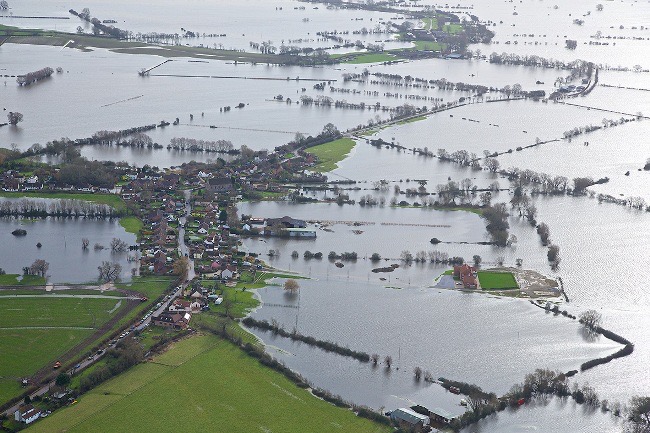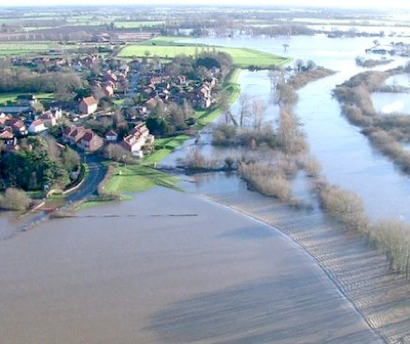
I have been aware of flooding of houses as a problem for a long time, perhaps from the time in the 60s when our own street flooded. When buying a house in the Fens an early essential question was how high we were above the river level. The answer was not much, perhaps 6 m above sea level and three above the usual river level, but more importantly we were at the high point in the village and above most of Cambridge, so while the village might be cut off by flooding, our house would stay dry until a very large amount of the county was under water. In that house, despite being 60 miles from the sea we were conscious of the tide, because the river could not flow out if the sea was high, so the fresh water would back up. The Fens have carefully controlled water levels at the best of times and the management of water is a fine art, there. Thereafter we sought places on hills. top pic: https://www.metoffice.gov.uk/climate/uk/interesting
When in China such issues were largely avoided by living in high-rise apartments, but that doesn’t prevent flooding being an issue. In Nanjing on wet days the water would flood downhill through the shops and the mopping up was a frequent sight.
When we lived in Cornwall, a band colleague and friend lived in a valley bottom—the village stream ran through his garden— and, after his second flooding, he redecorated downstairs by extending the slate floor up the walls of the ground floor to a point he felt would be above likely flood levels. Thus on the next flood he moved furniture smartly, the bottom level of house flooded and on the third day after the flood subsided, all was restored to its previous condition, with no new damage.
All of which tells us that flooding is a problem we can cope with.
We do not need to build on floodplains and I have been reading about the error in so doing for a long, long time. Parts of York are 5 metres below the ambient river level and building so far below such a datum seems to me to be a recipe for disaster. Indeed, I feel this so strongly that I do not see why the state should provide significant reparation for such silly mistakes; from where I have been viewing this situation, the state is effectively encouraging people to make avoidable mistakes. As our weather becomes more violent, we will presumably have similar issues with wind-proofing and people like myself who try to live on hilltops will be at risk of a different sort of storm damage. I look at the damage in the US this week following 200mph winds and wonder (yet again) why we don’t build into the earth. Looking at 70mph winds in Scotland several times in December 2015, I have been thinking the same, as I don’t think my house will survive 70mph winds unscathed. To put such winds in perspective, ¹ I think many of us are blown away (lifted off our feet) in a 70mph and we have difficulty walking in winds over 40mph. The construction issue with wind is that we build with an assumption that gravity will hold everything in place. As regards flooding, we build with an assumption that water will not get into the house.
When flooding occurs, water comes into the house in three ways; from above, from below and through the openings. From above will not occur before you have lost cover; from below occurs when the floors are porous (coming through a suspended floor) and through the openings (doors, air-bricks, windows, around pipe openings implies a different set of issues and explains the liberal use of sandbags.) ² Some of these can be avoided by intelligent attention to building detail (air-bricks, pipe openings), some (doors and windows) represent a different class of problem. I suggest that once water has passed cill height the house will flood soon whatever is done.
So if you are going to live in an area liable to flooding and you are determined to make the best of that, what can you do?
In terms of portable solutions, you can store some sandbags and their equivalents. You can look hard for problem areas such as pipe openings and air-bricks and deal with them on a case by case basis. At such times you have a target protection level in mind, let us say ground floor window cill height.
In terms of construction solutions, you want slab flooring (probably concrete and screed), you probably want water-tolerant surfaces such as stone (slate, hard tile) and you want to extend this up the walls to your target height. There’s a challenge to do that in an attractive way, but we’re good at invention (although bad, usually, at spending). You do not really want to aim to keep the water out—the pressure is so great that it is likely to do far greater damage than you expect. Materials than respond badly to water damage include timber, plasterboard, insulation of rockwool and similar, handmade bricks, all mdf and other manufactured wood. If you were thinking to use plasterboard, then lay it landscape so it can be replaced easily.
I’d expect the dado rail to reappear in such housing, above the target height so as to define the change in materials, to accommodate the wiring and other services you’d like to keep dry. I’d expect that all sewerage in such housing areas to have non-return valves and I’d expect all electrical substations to be built on elevated platforms. I’d also expect that developments in flood plains would use designs that make the living spaces higher. Housing in my own immediate area is tall and narrow with the ground floor given over to utility and garage spaces; all of this would be easily built to be flood-survivable up to first floor level. I’d expect the ground floor to be built in engineering brick (we usually use this up to damp-proof course for expense reasons). I’d expect some change in foundation design. I’d expect change to supply and connections to electrical services.
With these changes, we might then accept that flooding occurs and that living in such a zone is not a life-changing experience. In a sense, accepting that the desperation to live in a particular area (location is all, we are told) is balanced by some inconvenience, but that the level of such inconvenience can be reduced to just that, inconvemience. ³
I am reminded of the three little piggies. When we make mistakes with our eyes open these are avoidable errors. There are elements in such decision that I might call due diligence and we have advisors who are supposed to help us make such decisions in an informed way. Sellers are supposed to supply honest information ³ but (bad) human behaviour pushes that honesty into a corner. I am ever hopeful that the pendulum will swing towards individual (and collective) responsibility for decisions, not the current reliance upon the nanny state to come rescue us. What we have is an extension of the free speech issue in the previous essay; not only do we claim to be able to say anything with no consequences, ⁴ we apparently wish to be able to do any number of stupid things and have everyone else (the state in some form) come make it right. Neither position is actually acceptable.
DJS 20160101
Sites visited (I really mean recorded, don’t I?):
http://www.nationalfloodforum.org.uk/bluepages/ 404 error 201707 Site has shrunk. Might be a water effect?
http://www.newground.co.uk/news-events-media/knowledge-centre/is-there-an-alternative-to-sandbags/
https://www.homebuilding.co.uk/building-in-a-flood-zone/ updated 20170711, following very nice note from the digital ops manager.
20170711 all links tested and some replaced.
1 Researching this, and having had trouble in the hills with small people with big rucsacs in 40mph winds, I found this answer: Let's do [some] math[s] before we look for information. First, what is the force that keeps you anchored to the ground? This is the force of static friction, which is Fs=μmg. What is this force opposing? The force of drag from the wind pushing on you. For the velocities involved (a high Reynolds number regime), the drag is quadratic in velocity, Fd=½ρv²CdA, where ρ is the density of atmosphere, v is the velocity, Cd is a dimensionless drag coefficient, and A is your body's cross-sectional area. So let's set the forces equal and solve for the velocity: v² = 2μmg / (ρCdA)
We'll be very ballpark about this. The density of air is ρ≈1.2 kg/m³ . I'll say your mass is 50 kg . Per this paper, we'll say CdA≈0.84 m² . Per this thread, we'll say μ=0.4 . Putting all these numbers in gives us v≈20 m/s , or about 45 mph. But, this is just enough to make your body move (compared to standing still on the ground). It would take at least a 70 mph wind to overcome the force of gravity, and even then, that's assuming the wind keeps pushing on you with your body turned to face it (or away from it), not sideways. Hard thing to guarantee given how the body is likely to tumble or spin.

2 Are sandbags a good solution to flooding? The sacks are easy to store, sand or a substitute should be easily found (e.g garden soil). The requirement is something heavy enough not to drift away, flexible enough to stay in place and fill gaps. Sacks can be used for other things; Many of the alternatives broadcast that flooding is a problem (and that brings an element of shame?)
Alternatives here: sandbag alternatives {Absorbeez, Floodsax, Aquasac, etc}, air-brick solutions such as snorkel vents, door barriers {Floodgate, DoorDam}, clever seals that expand in flooding and so on.
3 In an environment of ambulance chasers and the current blame culture, the safest reply to requests for information for which you will not be thanked but only pursued is “I don’t know”. This is not a good position to be in. It is in everyone’s interests that information be available BUT if the response to all supply is simply more questioning and demand for ever greater detail then the natural response is to shut down this interaction early. Caveat emptor (buyer beware) is a good guide, but when the buyer persists in making the seller’s life uncomfortable, this pushes us to a position where the seller refuses to complete the sale. Indeed, it begs the question of when in such a process the seller can still pull out; similarly when the point is at which the buyer no longer has a claim upon the seller’s response. Observed habit in Britain is that once a sale has completed (the money moved, the title transferred) the vendor tries very hard to have nothing further to do with the vendee (buyer). That applies to cars as much as houses, which is why one may prefer to buy cars from a business—they can’t easily hide.

4 There is very little free speech left in both the US and the UK, places that proclaim such an ideal. See a decent example explanation Times article by Matthew Parris. Indeed, have a good wide read about this before I write about it too. Next Essay.
Drown-proofing, the alternative title for this piece, is the title of a book we, the family, found on one of our trips to Hay-on-Wye’s bookshops. See the wikipedia entry. And perhaps here.